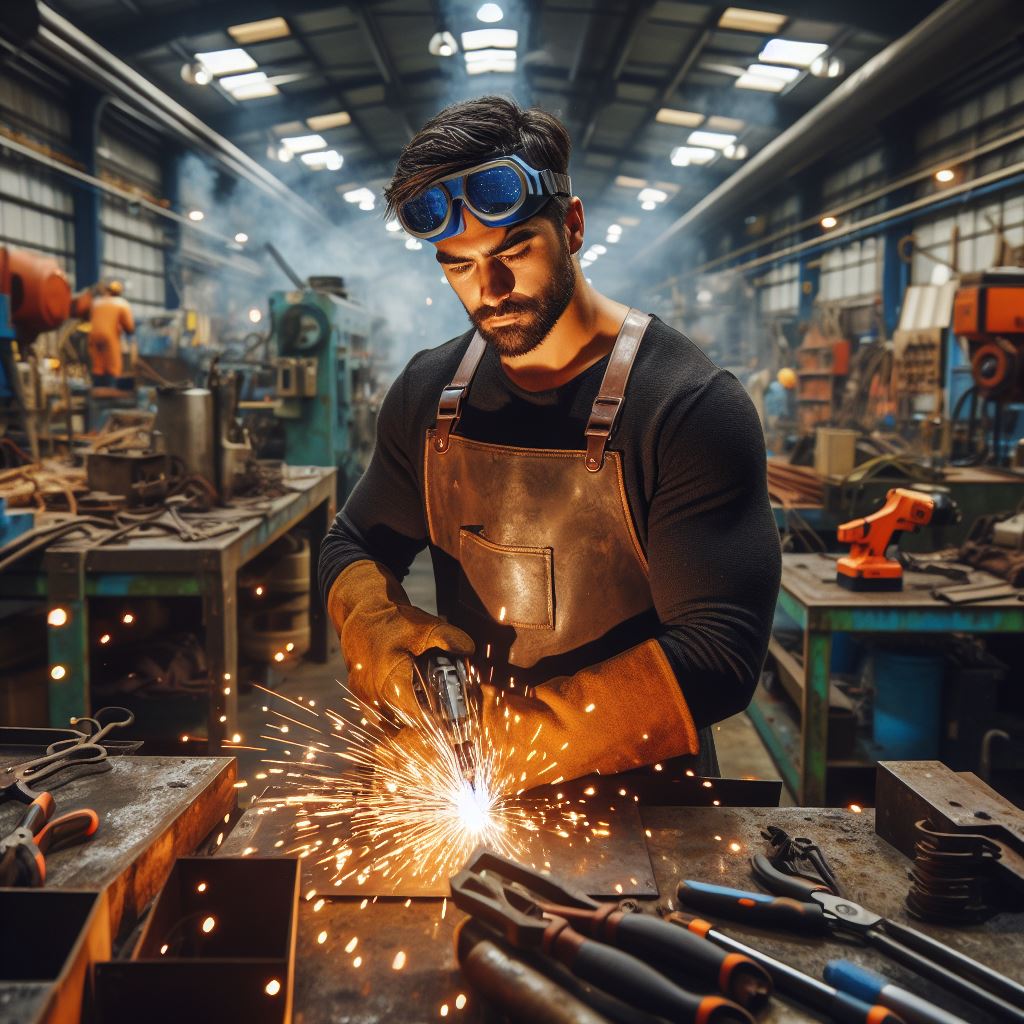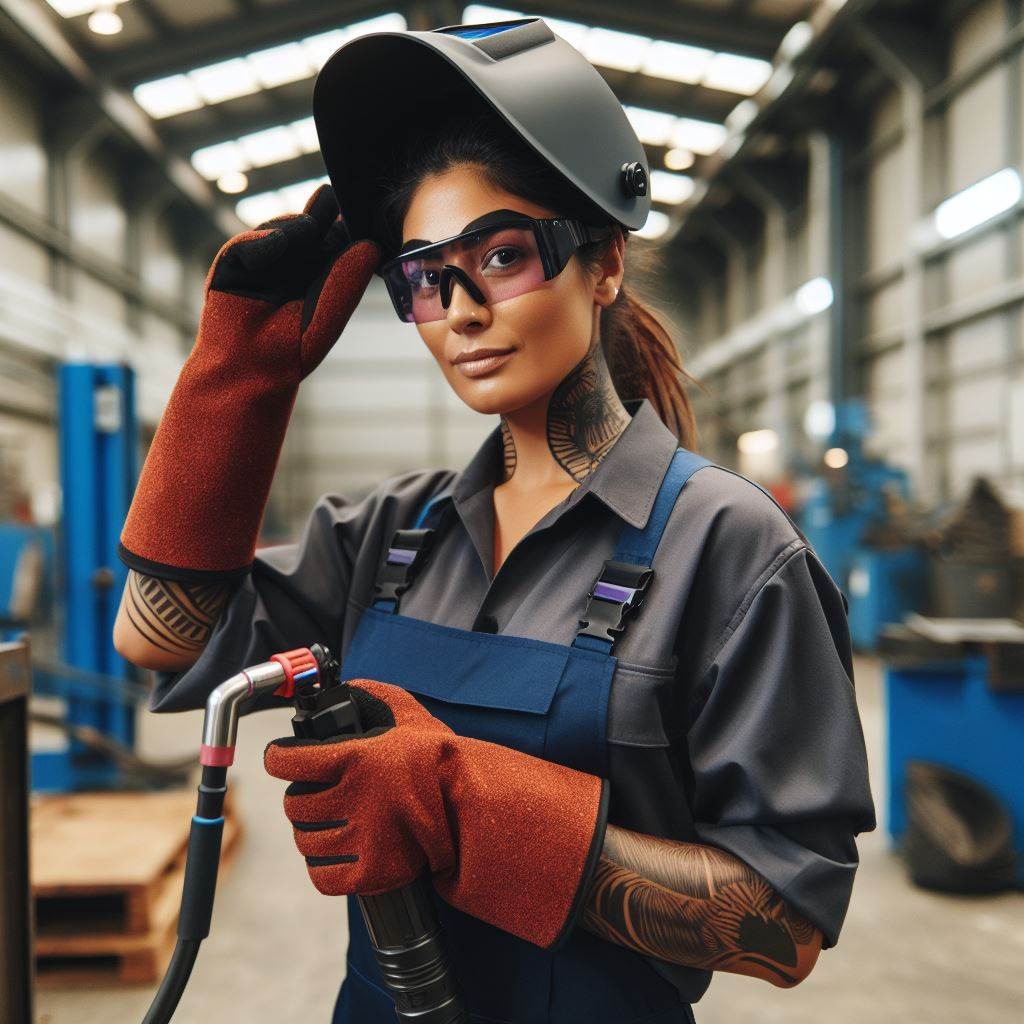Introduction
- Welding technology stands as a cornerstone for progress in various sectors, encompassing infrastructure development, manufacturing advancements, and technological innovation.
- The realm of welding has witnessed a significant transformation with the emergence of advanced techniques, reshaping traditional methods and introducing groundbreaking processes.
These advancements not only enhance the efficiency and precision of welding but also contribute to the overall quality and durability of welded structures. - New Zealand has firmly positioned itself at the forefront of this technological evolution, leveraging its expertise and innovation prowess to pioneer novel approaches in welding.
With a commitment to excellence and a drive for continuous improvement.
New Zealand’s contributions to the field of advanced welding technology have garnered global recognition, solidifying its reputation as a leading hub for innovation and excellence in welding practices.
Evolution of Welding Technology
Historical background of welding techniques
- Welding is an ancient practice dating back to the Bronze Age.
- Early techniques included forge welding, wherein two pieces of metal were heated and hammered together.
- In the Middle Ages, pressure welding and autogenous welding techniques were developed.
- The 19th century saw the introduction of arc welding, using electricity to create welds.
- The concept of gas welding emerged with the invention of the oxy-fuel process in the late 1800s.
- World War I and II played a significant role in advancing welding techniques for military applications.
- The post-war era saw a surge in the need for welding in various industries, driving further innovation.
Introduction of advanced welding processes
- The 20th century witnessed the development of various advanced welding processes.
- Gas metal arc welding (GMAW), commonly known as MIG welding, became popular for its versatility and high welding speeds.
- Tungsten inert gas (TIG) welding emerged as a precision welding technique, ideal for thin materials and critical applications.
- The advent of plasma arc welding enabled superior control over the welding arc, resulting in higher-quality welds.
- Laser welding, introduced in the 1960s, revolutionized welding by delivering concentrated energy for precise and efficient joining.
- Electron beam welding, utilizing a high-velocity electron beam, became prevalent for its deep penetration capabilities.
- Friction stir welding, a solid-state welding process, offered a breakthrough for joining lightweight materials like aluminum.
Role of technology advancements in improving welding efficiency and quality
- Technological advancements have significantly enhanced welding efficiency and quality.
- Automation and robotics have improved productivity, accuracy, and repeatability in welding processes.
- Computerized control systems enable real-time monitoring and adjustment of welding parameters for optimal results.
- Advanced sensors and imaging technologies ensure accurate joint alignment and defect detection.
- Digitalization and data analysis enable continuous process improvement and predictive maintenance.
- High-performance welding power sources provide precise control over heat input and arc characteristics.
- 7. The development of advanced welding consumables has further enhanced weld quality and performance.
In a nutshell, the evolution of welding technology has a rich historical background, ranging from ancient forge welding to modern advanced processes such as laser welding and friction stir welding.
These advancements, driven by technology and innovation, have greatly improved welding efficiency and quality.
Today, automation, robotics, computerized control systems, and advanced sensors play crucial roles in achieving precise and reliable welds.
With ongoing research and development, the welding industry continues to push the boundaries of what is possible in joining various materials.
Leading to new opportunities and advancements in manufacturing and construction sectors.
Advanced Welding Techniques in New Zealand
Overview of New Zealand’s welding industry
New Zealand’s welding industry plays a crucial role in various sectors such as construction, manufacturing, and infrastructure development.
With a strong emphasis on quality and innovation, the industry has seen significant growth in recent years.
Welding is a fundamental process in joining metals, and New Zealand’s welding industry is known for its skilled workforce and advanced technologies.
The industry adheres to international standards and regulations to ensure the safety and integrity of welded structures.
Emphasis on the use of advanced welding techniques
To maintain a competitive edge in the global market, New Zealand has embraced advanced welding techniques that enhance productivity, efficiency, and quality.
Advanced welding techniques offer numerous benefits, including reduced welding time, improved weld quality, and enhanced structural integrity.
One of the key advancements in the industry is the adoption of robotic welding.
Robotic welding systems are capable of performing complex welds with precision, increasing production rates and reducing human error.
Automation has revolutionized the welding process and made it more efficient and cost-effective.
Furthermore, New Zealand has also embraced laser welding technology. Laser welding provides a high-energy density, allowing for deep penetration and precise control over the heat input.
This technique is particularly advantageous for welding thin materials and complex geometries, enabling the industry to produce intricate and lightweight structures.
Specific welding methods and their applications in New Zealand
- Gas Metal Arc Welding (GMAW): GMAW, also known as MIG welding, is widely used in New Zealand’s welding industry. It is a versatile method suitable for various materials and thicknesses. GMAW is commonly used in automotive manufacturing, construction, and general fabrication.
- Gas Tungsten Arc Welding (GTAW): GTAW, commonly referred to as TIG welding, is extensively used in New Zealand for welding stainless steel, aluminum, and other non-ferrous metals. It offers excellent control over the welding process and produces high-quality welds, making it ideal for precision applications in sectors such as aerospace and food processing.
- Flux-Cored Arc Welding (FCAW): FCAW is widely used in heavy fabrication applications in New Zealand, particularly for welding thick materials and in outdoor environments. It provides deep penetration and high deposition rates, making it suitable for structural welding and shipbuilding.
- Resistance Spot Welding (RSW): RSW is commonly used in New Zealand’s automotive industry for joining sheet metal components. This method creates a strong and reliable weld by passing an electrical current through the interface of the materials, generating localized heat without melting the entire workpiece.
In essence, New Zealand’s welding industry has embraced advanced welding techniques to stay ahead in a competitive global market.
With the adoption of robotic welding, laser welding, and various other methods, the industry has witnessed increased efficiency, improved quality, and enhanced structural integrity.
These advancements have positioned New Zealand as a leader in welding technology, contributing to the growth and development of various sectors within the country.
Benefits of Advanced Welding Technology
Increased efficiency and productivity
- Advanced welding technology enables faster and more efficient welding processes.
- It allows welders to complete projects in a shorter amount of time, increasing productivity.
- With high-tech welding equipment, operators can perform multiple welds simultaneously, saving time and effort.
- Automated welding systems reduce the need for manual labor, resulting in higher efficiency.
Improved weld quality and strength
- Advanced welding techniques deliver superior weld quality compared to traditional methods.
- Precise control over weld parameters ensures consistent and strong joint formations.
- Welds created by advanced technology are less prone to defects and failures, improving overall product performance.
- The use of computer-controlled welding systems ensures accurate positioning of welds for optimal strength.
Reduction in waste and rework
- Advanced welding technology minimizes material wastage during the welding process.
- Precise control over the heat input and weld bead size reduces the need for excessive material usage.
- High-quality welds produced by advanced methods require fewer rework and repairs, reducing costs.
- Optimized welding techniques and parameters minimize distortion, reducing the need for post-weld corrections.
Enhanced safety measures
- Advanced welding technology incorporates safety features to protect operators and the surrounding environment.
- Welding equipment with built-in monitoring systems detects and prevents potential hazards, ensuring a safer working environment.
- Automated welding processes minimize human exposure to hazardous fumes, sparks, and radiation.
- Improved ergonomics in welding equipment design reduces operator fatigue and the risk of work-related injuries.
In general, advanced welding technology offers numerous benefits that contribute to the success and competitiveness of the welding industry.
Increased efficiency and productivity enable faster project completion, while improved weld quality ensures superior product performance.
The reduction in waste and rework saves costs and resources, while enhanced safety measures prioritize the well-being of operators.
By embracing advanced welding technology, New Zealand can gain a significant edge in the global welding market.
Read: Top Carpentry Courses in New Zealand
Impact on Various Industries
Role of advanced welding technology in the construction sector
- Advanced welding techniques are used in the construction industry to connect structural components.
- This technology improves the quality and strength of welds, ensuring structural integrity of buildings.
- It allows for more efficient construction processes by reducing the time and labor required.
- Advanced welding technology also enables the use of new materials, such as high-strength alloys, in construction.
- Overall, it enhances the durability and safety of buildings, making them more resistant to external forces.
Benefits of advanced welding techniques in automotive manufacturing
- The automotive industry relies heavily on welding to join various components of vehicles.
- Advanced welding technology allows for precise and strong welds, ensuring the structural integrity of vehicles.
- It improves the efficiency of the manufacturing process and reduces production costs.
- Advanced welding techniques also enable the use of lightweight materials, leading to fuel efficiency in vehicles.
- Furthermore, it enhances the overall safety of vehicles, making them more resistant to collision impacts.
Application of advanced welding in aerospace and marine industries
- In the aerospace industry, advanced welding techniques are crucial for joining aircraft components.
- These techniques provide high-strength and reliable welds, ensuring the safety of aircraft.
- Advanced welding technology allows for the use of lightweight materials, improving fuel efficiency and performance.
- It also facilitates the construction of complex shapes and structures, enhancing aerodynamics.
- In the marine industry, advanced welding is used in shipbuilding and repair, ensuring structural integrity.
- It enables the use of corrosion-resistant materials, enhancing the longevity of marine vessels.
In review, advanced welding technology has a significant impact on various industries. In the construction sector, it improves the quality, efficiency, and durability of buildings.
With automotive manufacturing, it ensures the strength, safety, and fuel efficiency of vehicles.
In aerospace and marine industries, it enables the use of lightweight materials, enhances performance, and ensures structural integrity.
The advancements in welding technology have revolutionized these industries, making them more efficient, safer, and technologically advanced.
Read: NZ Carpentry: Skills and Tools Needed

Training and Education Opportunities
Overview of Educational Institutions Offering Welding Programs in New Zealand
- New Zealand Welding School is a leading provider of welding education with modern facilities.
- Wellington Institute of Technology offers a comprehensive welding program with industry-relevant training.
- Ara Institute of Canterbury provides welding courses that combine theoretical knowledge with practical skills.
- Eastern Institute of Technology offers a specialized welding program for students interested in advanced techniques.
- Manukau Institute of Technology provides hands-on training in welding for aspiring professionals.
Specialized Training and Certifications for Advanced Welding Technology
- Welding inspectors can pursue certification through the Welding Technology Institute of Australia, which is recognized globally.
- The International Institute of Welding offers certification programs, including those for welding engineers and supervisors.
- New Zealand Welding School offers specialized courses in advanced welding techniques such as robotic welding and underwater welding.
- Advanced certification programs are available for professionals looking to specialize in niche areas like aerospace welding or pipeline welding.
- Continuous learning and professional development are essential to keep up with the advancements in welding technology.
Importance of Continuous Learning and Upskilling in the Field
Welding technology is constantly evolving, and staying up-to-date with the latest techniques and equipment is crucial for a successful career in the field.
Continuous learning allows welders to enhance their skills, adapt to changing industry demands, and stay competitive in the job market.
Upskilling in advanced welding technology opens doors to more specialized job opportunities and higher earning potential.
Employers also value welders who invest in their professional development, as it demonstrates dedication and a commitment to excellence.
Personalized Career Consulting
Unlock your potential with expert career advice tailored to your goals. Get personalized guidance and actionable steps toward your dream career in New Zealand.
Get StartedBy participating in continuous learning programs and acquiring certifications, welders can enhance their knowledge and expertise, making them valuable assets to their employers.
Moreover, continuous learning helps ensure that welders are aware of the latest safety regulations and best practices in the industry, promoting a safer working environment.
Training and education opportunities in welding provide individuals with a strong foundation and equip them with the necessary skills to excel in their careers.
Whether it’s completing a welding program at an educational institution or pursuing specialized certifications, investing in training is a wise choice for aspiring welders.
In fact, training and education opportunities in welding are widely available in New Zealand, with several educational institutions offering comprehensive programs.
Specialized training and certifications in advanced welding technology further enhance a welder’s skill set and open doors to specialized job opportunities.
Continuous learning and upskilling are essential for staying competitive in the field and meeting industry demands.
By investing in training and education, individuals can build a successful career in welding while ensuring their skills remain up-to-date and valuable in the ever-evolving industry.
Read: Carpenter Apprenticeships in NZ Explained
Future Trends and Innovations
Introduction to current research and developments in welding technology
Welding technology has come a long way in recent years, with constant research and development aiming to improve efficiency, durability, and usability.
Many advancements are being made in various aspects of welding, including equipment, materials, techniques, and automation.
One area of current research is the development of advanced welding processes, such as laser welding and friction stir welding.
These processes offer higher precision and speed, allowing for increased productivity and improved weld quality.
Researchers are exploring ways to optimize these processes and make them more accessible to industries.
Another focus of research and development is the use of innovative materials in welding. Traditionally, welding has been primarily limited to steel and other metals.
However, there is now a growing interest in welding dissimilar materials, such as joining metals with composites or polymers.
This opens up new possibilities for lightweight structures and advanced material combinations.
Potential impact on New Zealand’s welding industry
As advancements in welding technology continue, there is the potential for significant impacts on New Zealand’s welding industry.
These innovations can lead to increased productivity, improved weld quality, and reduced costs.
The adoption of advanced welding processes and materials can make Kiwi businesses more competitive both domestically and internationally.
The use of advanced welding techniques can also address some of the challenges faced by the industry.
For instance, the demand for skilled welders is often high, and automation can help bridge the gap by taking on repetitive or hazardous tasks.
Automation can also improve safety by reducing the exposure of workers to hazardous environments.
Implications for the economy and employment opportunities
The advancements in welding technology can have significant implications for the New Zealand economy.
By adopting more efficient and cost-effective welding processes, businesses can potentially increase their profitability, leading to economic growth.
The use of innovative materials can also enable the development of new industries or the expansion of existing ones.
Moreover, the adoption of advanced welding technology can create new employment opportunities.
While some traditional welding jobs may be reduced due to automation, there will be a demand for skilled workers who can operate and maintain advanced welding equipment.
The need for engineers, technicians, and researchers in welding technology will also grow with the industry.
In a nutshell, the current research and developments in welding technology offer exciting opportunities for New Zealand’s welding industry.
The introduction of advanced processes, materials, and automation can lead to increased productivity, improved weld quality, and reduced costs.
These advancements have the potential to drive economic growth and create new employment opportunities, making New Zealand’s welding industry even more competitive on the global stage.
Transform Your Career with a Professional CV and Cover Letter
Stand out to employers with an ATS-optimized resume and tailored cover letter designed to match your dream role. Let us craft your job application materials for success!
Get StartedRead: Kiwi Carpenter Salary Insights 2024
Conclusion
Recap of the importance of advanced welding technology
Advanced welding technology is of utmost importance in various industries, ensuring efficient and high-quality welding processes.
It plays a vital role in improving productivity and safety while reducing costs.
Emphasis on New Zealand’s position as a leader in the field
New Zealand has emerged as a leader in advanced welding technology, with its innovation and expertise attracting global attention.
The country’s commitment to research and development has placed it at the forefront of this industry.
Encouragement to explore the opportunities and potential in advanced welding technology in New Zealand.
For individuals passionate about welding and seeking new challenges, New Zealand offers exciting opportunities in the field of advanced welding technology.
It provides a supportive environment, cutting-edge facilities, and a skilled workforce that fosters growth and innovation.
In closing, advanced welding technology is vital for modern industries, and New Zealand’s prominence in this field cannot be ignored.
Its commitment to innovation and its position as a global leader make it an ideal destination for those interested in exploring the potential of advanced welding technology.
So, don’t hesitate to dive into the world of advanced welding technology in New Zealand; it may open doors to a rewarding and prosperous career.




